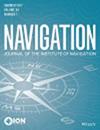Precise Onboard Time Synchronization for LEO Satellites
IF 2
3区 地球科学
Q1 ENGINEERING, AEROSPACE
引用次数: 6
Abstract
Onboard time synchronization is an important requirement for a wide range of low Earth orbit (LEO) missions such as altimetry or communication services, and extends to future position, navigation, and timing (PNT) services in LEO. For GNSS-based time synchronization, continuous knowledge about the satel lite’s position is required and, eventually, the quality of the position solution defines the timing precision attainable through GNSS measurements. Previous research has shown that real-time GNSS orbit determination of LEO satellites can achieve decimeter-level accuracy. This paper characterizes the performance of GNSS-based real-time clock syn chronization in LEO using the satellite Sentinel-6A as a real-world case study. The satellite’s ultra-stable oscillator (USO) and triple-frequency GPS/Galileo receiver provide measurements for a navigation filter representative of real-time onboard processing. Continuous evaluation of actual flight data over 14 days shows that a 3D orbit root-mean-square (RMS) error of 11 cm and a 0.9-ns clock standard deviation can be achieved.低轨道卫星精确星载时间同步
机载时间同步是广泛的低地球轨道(LEO)任务(如测高或通信服务)的重要要求,并扩展到未来的低地球轨道定位、导航和授时(PNT)服务。对于基于GNSS的时间同步,需要持续了解卫星生命的位置,最终,位置解的质量定义了通过GNSS测量可获得的授时精度。已有研究表明,低轨道卫星实时GNSS定轨精度可达到分米级。本文以Sentinel-6A卫星为例,分析了基于gnss的低轨道实时时钟同步性能。卫星的超稳定振荡器(USO)和三频GPS/伽利略接收机为实时机载处理的导航滤波器提供测量。对14天的实际飞行数据的连续评估表明,三维轨道均方根误差(RMS)为11 cm,时钟标准差为0.9 ns。
本文章由计算机程序翻译,如有差异,请以英文原文为准。
求助全文
约1分钟内获得全文
求助全文
来源期刊

Navigation-Journal of the Institute of Navigation
ENGINEERING, AEROSPACE-REMOTE SENSING
CiteScore
5.60
自引率
13.60%
发文量
31
期刊介绍:
NAVIGATION is a quarterly journal published by The Institute of Navigation. The journal publishes original, peer-reviewed articles on all areas related to the science, engineering and art of Positioning, Navigation and Timing (PNT) covering land (including indoor use), sea, air and space applications. PNT technologies of interest encompass navigation satellite systems (both global and regional), inertial navigation, electro-optical systems including LiDAR and imaging sensors, and radio-frequency ranging and timing systems, including those using signals of opportunity from communication systems and other non-traditional PNT sources. Articles about PNT algorithms and methods, such as for error characterization and mitigation, integrity analysis, PNT signal processing and multi-sensor integration, are welcome. The journal also accepts articles on non-traditional applications of PNT systems, including remote sensing of the Earth’s surface or atmosphere, as well as selected historical and survey articles.
 求助内容:
求助内容: 应助结果提醒方式:
应助结果提醒方式:


